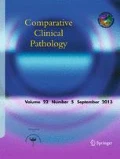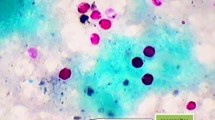Abstract
Lawsonia intracellularis is the causative agent of proliferative enteropathy (PE) in pigs, a disease of economic importance worldwide. The present study aimed to investigate the occurrence of L. intracellularis in ostriches using a sensitive and specific nested polymerase chain reaction (nested PCR). A total number of 112 fecal samples (64 healthy, 48 diarrheic) were collected from 11 ostrich farms located in four provinces in Iran (Semnan, Tehran, Gilan, Yazd). The results showed the presence of L. intracellularis in three diarrheic and four apparently healthy birds. The frequency of positive results was the same in both groups (6.25% healthy vs. 6.25% diarrheic). Although the results of this study did not reveal any relationship between this organism and diarrhea (P > 0.05), the molecular detection of L. intracellularis on a farm where birds were suffering from the typical clinical symptoms of PE highlights the need for evaluation of PE in ratites.
Similar content being viewed by others
References
Askari Badouei M, Zahraei Salehi T, Mirbehbahani SJ, Koochakzadeh A (2014) The first molecular investigation of Lawsonia intracellularis in dromedary camels. J Camel Pract Res 21:219–221
Benson F (2012) Ostrich farming business planning - planning profitable ostrich farming from “Farm to Plate”.http://www.world-ostrich.org/member/download/e-book-business-planning.pdf. Accessed 2 Aug 2015
Cooper DM, Swanson DL, Barns S, Gebhart C (1997a) Comparison of 16S ribosomal DNA sequences from the intracellular agents of proliferative enteritis in a hamster, deer, and ostrich with the sequence of a porcine isolate of Lawsonia intraellularis. Int J Syst Bacteriol 47:635–639
Cooper DM, Swanson DL, Gebhart CJ (1997b) Diagnosis of proliferative enteritis in frozen and formalin-fixed, paraffin-embedded tissues from a hamsters, horse, deer and ostrich using a Lawsonia intracellularis-specific multiplex PCR assay. Vet Microbiol 54:47–62
Guedes RMC (1998) Known facts about the epidemiology of porcine proliferative enteropathy. Thai J Vet Med 38:9–17
Hossain MM, Oh Y, Cho H (2016) Prevalence of antibody to and DNA of Lawasonia intracellularis in samples from wild animals in Korea. J Wildl Dis 52:802–808
Jones GF, Ward GE, Murtaugh MP, Lin G, Gebhart CJ (1993) Enhanced detection of intracellular organism of swine proliferative enteritis, Illeal symbiont intracellularis, in feces by polymerase chain reaction. J Clin Microbiol 31:2611–2615
Lemarchand TX, Tulley TNJ, Shane SM, Duncan DE (1997) Intracellular campylobacter-like organisms associated with rectal prolapse and proliferative enteroproctitis in emus (Dromaiusnovaehollandiae). Vet Pathol 34:152–156
Nascimento Chiriboga AE, Guimaraes WV, Vanetti MC, Araujo EF (1999) Detection of Lawsonia intracellularis in faeces of swine from the main producing regions in Brazil. Can J Microbiol 45:230–234
Ohta T, Kimura K, Katsuda K, Kobayashi H, Mikami O, Haritani M (2016) Prolifarative enteropathy caused by Lawsonia intracellularis in chickens. J Comp Pathol 156:158–161
Sampieri F, Vannucci FA, Allen AL, Pusterla N, Antonopoulos AJ, Ball KR, Thompson J, Dowling PM, Hamilton DL, Gebhart CL (2013) Species-specificity of equine and porcine Lawsonia intracellularis isolates in laboratory animals. Can J Vet Res 77:261–272
Shanawany MM (2014) Title of subordinate document. In: Recent developments in ostrich farming. http://www.fao.org/docrep/v6200t/v6200T02.htm. Accessed 27 May 2017
Vannucci FA, Gebhart CJ (2014) Recent advances in understanding the pathogenesis of Lawsonia intracellularis infections. Vet Pathol 51:465–477
Vannucci FA, Pusterla N, Mapes MS, Gebhart C (2012) Evidence of host adaptation in Lawsonia intracellularis infections. Vet Res 43:53–62
Author information
Authors and Affiliations
Corresponding author
Ethics declarations
Conflict of interest
The authors declare that they have no conflict of interest to declare.
Ethical approval
All applicable international, national, and/or institutional guidelines for the care and use of animals were followed. This article does not contain any studies with human participants performed by any of the authors.
Informed consent
Since there was no human participant in this study, no consent was necessary. The name of ostrich farms kept private for ethical reasons.
Rights and permissions
About this article
Cite this article
Koochakzadeh, A., Zahraei Salehi, T., Dehghan Rahimabadi, P. et al. Molecular investigation of Lawsonia intracellularis in diarrheic and healthy captive ostriches (Struthio camelus) in Iran. Comp Clin Pathol 28, 249–252 (2019). https://doi.org/10.1007/s00580-018-2823-1
Received:
Accepted:
Published:
Issue Date:
DOI: https://doi.org/10.1007/s00580-018-2823-1




